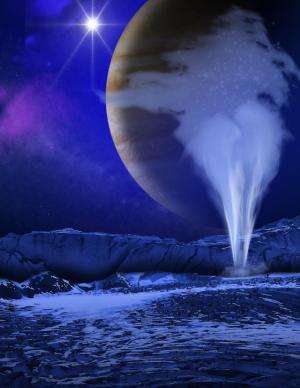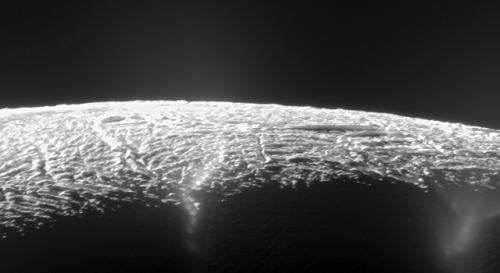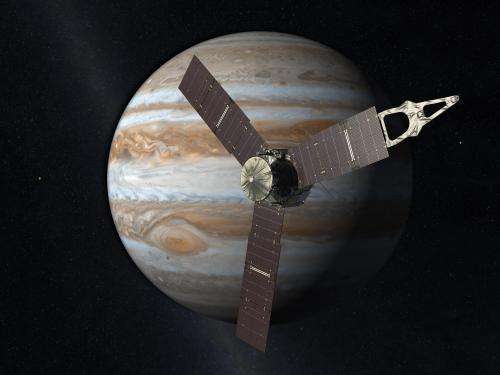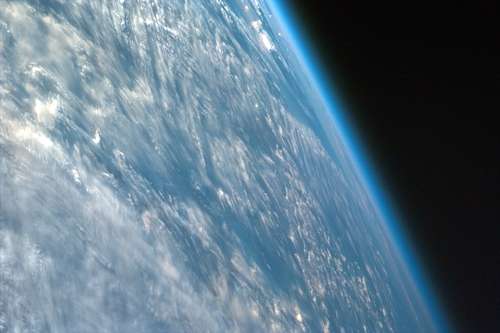How can we search for life on icy moons such as Europa?

Our solar system is host to a wealth of icy worlds that may have water beneath the surface. The Cassini spacecraft recently uncovered evidence of a possible ocean under the surface of Saturn's moon, Mimas.
Mimas is not alone in the possibility of having a global ocean, which would potentially provide a foothold for life to exist. Other worlds under examination include Jupiter's moon, Europa. In 2013, NASA's Hubble Space Telescope observed evidence that Europa erupts water, while the Cassini spacecraft has observed geysers spewing on Saturn's moon, Enceladus.
How likely is habitability on such icy worlds, and how would we search for it? This is one of the questions driving a research team led by Isik Kanik at NASA's Jet Propulsion Laboratory in Pasadena, California. Kanik's team was selected for a new grant from the NASA Astrobiology Institute for a five-year project looking at how metabolism could come about by way of chemical differences on icy worlds, and how signatures of these unbalanced states can be detected. This is assuming that metabolism works similarly on these other worlds as it does on Earth.
One of the ways Kanik's team will look for these signatures is to use analog environments on Earth. These are locations that scientists believe are similar, in certain respects, to what could be present on other worlds. In theory, life on another world could evolve from a chemical soup similar to that of certain places on Earth, such as within hot springs.
The Cedars, in California, and Cabeco de Vide, in Portugal, host natural springs that represent two extreme metabolic environments, with energy sources produced by water-rock interactions and particular types of organisms that find a way to take advantage of them, Kanik said.
"The sites are accessible field analogs to deep-sea hydrothermal systems on Earth's seafloor, which are very costly to explore. These are life-supporting environments similar to those that could exist on Europa or early Mars, Kanik said.
Moving life from vents to the surface
Members of Kanik's group have been at work with some of their research for decades, long before astrobiology was considered a distinct study of its own. This is their second grant with the NASA Astrobiology Institute; the first proposal, selected five years ago, focused on how life could have emerged from hydrothermal vents in the ocean.
"That's important because NASA is considering sending a spacecraft to Europa," Kanik said. "If they go and look for signatures of life, how are they going to interpret findings of organic molecules? That was the basic driver."

Another major part of the research was modeling how life could evolve in the laboratory environment. Championed by the NASA Astrobiology Institute's Michael Russell, the sub-team set up experiments in a hydrothermal reactor in the laboratory using simulated ocean water, some organic molecules, and then "mixing them and looking at what comes out," Kanik said.
The team produced about 250 papers based on their work over five years, he noted. Among the major milestones:
- The construction and use of the hydrothermal reactor for life experiments (Mielke et al., "Design, fabrication, and test of a hydrothermal reactor for origin-of-life experiments," Astrobiology 10(8), 2010.)
- Finding methane that arose abiotically, or without the presence of life, and that was transported from igneous mafic rocks through rain or snow. (Etiope et al., "Methane in serpentinized ultramafic rocks in mainland Portugal," Marine and Petroleum Geology 45 (2013).)
- How laboratory simulations have revealed that interactions between geology and energy sources—interactions that produce chemistry that could lead to life—are somewhat similar to how a fuel cell works. (Barge et al., "The fuel cell model of biogenesis: A new approach to origin-of-life simulations," Astrobiology 14(3), 2014.)
- How geologic disequilibrium may lead to life in submarine environments. (Russell, M. et al. "The drive to life on wet and icy worlds," Astrobiology 14(4), 2014.)
How life came to be in icy worlds
The new research focuses on four questions that are related to the possible emergence and evolution of life in icy environments, particularly in locations in the Universe such as Europa, Enceladus and Jupiter's moon Ganymede.
The first question asks, "What geological and hydrologic factors drive chemical disequilibria at water-rock interactions on Earth and other worlds?" The researchers will conduct laboratory experiments and field investigations to understand more about the chemistry, including factors such as acidity and electrochemistry.
"There are three basic ingredients for life to emerge: water, free energy and chemicals. Chemical reactions need to keep happening in one direction or the other—either using or giving off energy," Kanik said.
"As soon as reactions reach equilibrium, there is no energy to be used or made available. Therefore, once the system reaches equilibrium, nothing happens. So chemical disequilibrium is necessary for life to emerge."

A part of the investigation will involve going to geological field sites in California and Portugal using portable scientific instruments that were developed through past NASA funding. Under the first Icy Worlds project, team members Lance Christensen and Steve Vance have been developing tunable laser spectrometers (TLS) to investigate methane and other small molecules produced by serpentinization. The JPL TLS instrument on Curiosity, part of the Sample Analysis at Mars package, has been used on Mars to analyze elements in rocks and in the atmosphere as the Curiosity rover searches for ancient habitable environments at its main science destination of Mount Sharp (Aeolis Mons).
"We are going to take them to these sites and look at what kind of gases come out, and analyze the water and gases from these places," Kanik said. "We'll take some samples and bring them to the lab to make sure we have done it correctly."
The team also has a laboratory experiment to investigate serpentinization as it might have occurred on the early Earth before life emerged. This system provides a comparison of the natural sites where biology is present, allowing the team to understand the interaction between chemistry and biology.
The second question asks whether geo-electrochemical gradients—changes in geology and electrochemistry—in hydrothermal vents can eventually create chemistry that leads to life. Using fuel cells, the investigators will simulate how a vent system works, with the aim of understanding how they would behave on icy worlds.

Third, the research team will ask, "How, where and for how long might disequilibria exist in icy worlds, and what does that imply in terms of habitability?" This will involve making models of how seafloors may be different on icy worlds due to to factors such as temperature and pressure.
The fourth question asks, "What can observable surface chemical signatures tell us about the habitability of subsurface oceans?" Again, simulations will take place of icy bodies, including factors such as a vacuum, radiation and the appropriate surface temperatures. The aim here is to link what is seen on the surface with what is happening below.
While the exact budget has not been established yet for Kanik's team, on average the research groups awarded funding in this round received $8 million each. Kanik said the research will not only support dozens of scientists, but also provide extensive training for both graduate and undergraduate students training to become professional astrobiologists after graduation.
Source: Astrobio.net
This story is republished courtesy of NASA's Astrobiology Magazine. Explore the Earth and beyond at www.astrobio.net .





















